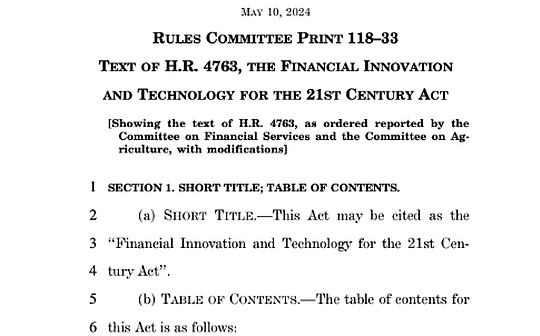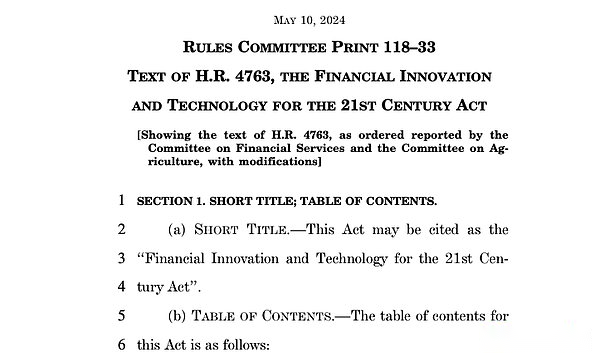
Written by: 0xjs & kimi
The U.S. Congress is about to usher in the latest crypto bill vote.On May 10, 2024, the U.S. House Rules Committee stated that the U.S. House of Representatives will hold a full vote on the Financial Innovation and Technology for the 21st Century Act (FIT21) this month.
A16z partner dixon posted on May 15 that “the House of Representatives will vote on the most important crypto bill to date FIT21. We have long called for clear regulation to protect consumers and innovation, and the FIT21 bill will doThis. Americans have embraced digital assets, but current regulatory approaches often limit innovation and privacy without really addressing the solutions needed to protect consumers or combat illegal activities. FIT21 will help eliminate scams and ensure transactions on cryptocurrencyThe oversight and protects American consumers by implementing strict rules on cryptocurrency transactions. FIT21 has bipartisan support because it addresses these issues. I encourage everyone who believes in the power of blockchain technology to support this legislation.”
background
On July 20, 2023, House Agriculture Committee Chairman Glenn “GT” Thompson, Rep. French Hill, Rep. Dusty Johnson, Whip Tom Emmer and Rep. Warren Davidson initiated HR 4763, the 21st Century Financial Innovation and Technology Act(FIT21).House Financial Services Committee Chairman Patrick McHenry is one of the co-sponsors of the legislation.
FIT21 sets clear and practical federal requirements for the digital asset market.It provides strong consumer protection and regulatory clarity for the digital asset ecosystem to flourish in the United States, cementing the U.S. leadership in the future global financial system, while strengthening our role as a hub for innovation.
The legislation gives the U.S. Commodity Futures Trading Commission (CFTC) new jurisdiction over digital commodities and defines the U.S. Securities and Exchange Commission (SEC) jurisdiction over digital assets as part of an investment contract.In addition, the bill establishes a process that allows digital goods to be traded in the secondary market (if they were originally provided as part of an investment contract).Finally, FIT21 provides comprehensive customer disclosure, asset protection and operational requirements for all entities that require registration with the CFTC and/or SEC.
Quickly view the main contents of the FIT21 Act

The FIT21 bill is 253 pages long, and a reporter from Bitchain Vision uses Kimi to summarize the bill.
The Financial Innovation and Technology Act of the 21st Century (H.R. 4763) is a comprehensive legislation aimed at regulating and promoting the development of digital assets and blockchain technology in the United States.Here is a detailed summary of the contents of the bill:
Part One: Definition, Rulemaking and Registration Notification
-
Definition: Define relevant terms, such as “digital assets”, “blockchain system”, “decentralized governance system”, etc.
-
Rulemaking: The Securities and Exchange Commission (SEC) and the Commodity Futures Trading Commission (CFTC) need to jointly formulate rules to further clarify relevant terms and formulate rules for mixed transactions in digital asset trading.
-
Registration Notice: Digital commodity exchanges, brokers and trading system operators are required to submit registration intention notices to the CFTC and comply with specific management requirements.
Part 2: Clarity of investment contract assets
The short title could be called “Securities Clarity Act of 2024,” indicating that the bill aims to provide clarity and clarity to certain assets in the securities market.The content of the relevant US federal securities bills has been revised, and special attention is paid to the definition and processing of “investment contract assets”.
(a) Amendment to Securities Act of 1933: Two major amendments were made to Section 2(a) of the Securities Act of 1933: The first amendment is in the definition of “security””Investment contract assets” are clearly excluded.This means that if an asset is classified as an investment contract asset, it will not be considered a securities in the traditional sense and thus may be subject to different regulatory requirements.The second amendment is the addition of the definition of “investment contract assets” at the end of Section 2(a) of the Securities Act.This definition contains three main conditions: 1. The asset must be a transferable number recorded on the distributed ledger without an intermediary, and is valued by encrypting and securely publicly disclosed.2. The assets must be sold or otherwise transferred, or intended to be sold or otherwise transferred as part of the investment contract.3. The asset itself is not considered a securities according to the first sentence of the Securities Law.
(b) Amendment to the Investment Advisers Act 1940: Section 202(a)(18) of the Investment Advisers Act of 1940, clearly states that the term “securities” does not include investment contractsassets.
(c) Amendment to the Investment Company Act 1940: Section 2(a)(36) of the Investment Company Act of 1940, also states that the term “securities” does not include investment contractsassets.
(d) Amendment to the Securities Exchange Act of 1934: Section 3(a)(10) of the Securities Exchange Act of 1934 is amended to clarify that the term “securities” does not include investment contract assets.
(e) Amendment to the Securities Investor Protection Act of 1970: Section 16(14) of the Securities Investor Protection Act of 1970, stating that the term “securities” does not include investmentContract assets.
The purpose of these revisions is to provide greater flexibility and clarity for digital assets within the existing securities legal framework while ensuring investor protection.By excluding investment contract assets from the definition of traditional securities, the bill aims to promote innovation while maintaining appropriate protection for investors.
The provisions of the second part are of great significance to digital asset issuers, investors and regulators.It provides legal clarity for the issuance and transaction of digital assets, helping to reduce regulatory uncertainty, which may encourage more investment and innovation to occur within the digital asset space.At the same time, by excluding investment contract assets as the definition of securities, a new path is also provided for the supervision of such assets.
Part 3: Provision and sales of digital assets
-
Exemption Transactions: Specific exemptions for digital asset transactions are specified.
-
Requirements: Set requirements for the provision and sale of certain digital assets.
-
Enhanced disclosure requirements: Requirements to enhance disclosure information of digital assets.
-
Certification: Certify certain digital assets.
Part 4: Digital Assets Registered with SEC
-
The handling of digital goods and other digital assets: stipulates the SEC’s regulatory authority over digital goods and other digital assets.
-
Registration and Requirements: Registration, requirements and rules related to digital asset brokers and traders involved in digital asset trading systems.
Part 5: Digital Assets Registered with CFTC
-
The jurisdiction of CFTC over digital commodity trading: It clarifies the scope of supervision of CFTC over digital commodity trading.
-
Registration and Supervision: Specifies registration and supervision requirements for digital commodity exchanges, brokers, trading consultants and commodity pool operators.
Part 6: Innovation and technological improvement
-
Survey and Report: SEC and CFTC are required to conduct research on financial technology innovation, decentralized finance, non-homogeneous digital assets, financial literacy of digital asset holders, and improvement of financial market infrastructure, and submit reports.
Other important terms and regulations
-
Effective Date of the Law: Most provisions will take effect 360 days after the promulgation of the Act and will take effect 60 days after the rule is made unless rulemaking is required.
-
Coordination between SEC and CFTC: The two institutions will jointly formulate rules to promote fair and orderly development of the digital asset market and protect investors.
-
International Coordination: The SEC and CFTC will coordinate with foreign regulators to establish consistent regulatory standards for global digital assets.
-
Bank Secrecy Law: The digital asset trading system is regarded as a financial institution and is applicable to the bank Secrecy Law.
Fees and funds
-
Fee Charge: CFTC will charge registration fees, annual fees and termination fees for entities that register digital commodity exchanges, brokers and trading systems.
-
Fee Adjustment: CFTC has the right to adjust fees as needed to promote fair competition and innovation.
-
Fee Use: The fees charged will be used to cover the cost of the CFTC’s functional implementation under this Act.
Research and Reports
-
Decentralized Finance Research: SEC and CFTC will jointly conduct research to analyze the nature, scale, role, use of decentralized finance and its degree of integration with traditional financial markets.
-
Research on non-homogenized digital assets: Study the nature, market and integration with traditional markets of non-homogenized digital assets.
-
Financial Literacy Research: Methods to Evaluate Improvement of Financial Literacy for Digital Asset Holders.
-
Financial Market Infrastructure Research: Assessment of whether additional guidance or rules are needed to facilitate the development of tokenized securities and derivatives.
in conclusion
The H.R. 4763 Act provides a comprehensive framework designed to regulate and promote the development of digital assets and blockchain technologies in the United States.The bill lays the foundation for growth and innovation in the digital asset market by defining key terms, setting registration requirements, enhancing disclosure and transparency, and promoting international regulatory coordination.In addition, the bill emphasizes the importance of research on financial technology and digital asset ecosystems, as well as raising public awareness and understanding of these emerging technologies.Through these measures, the bill aims to protect investors, maintain market integrity, and leverage the potential of digital assets and blockchain technology to enhance the U.S. economy.








